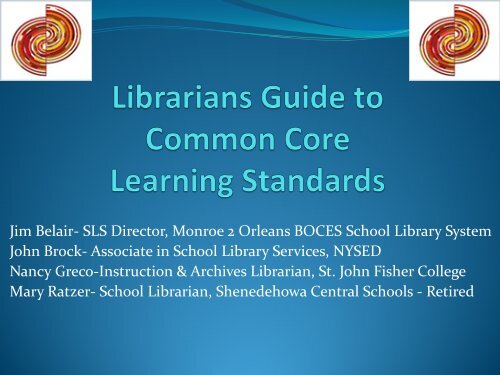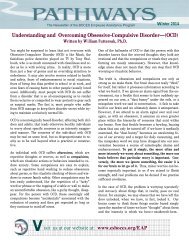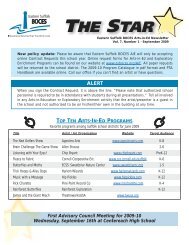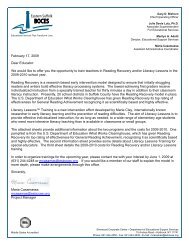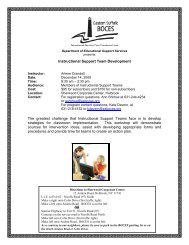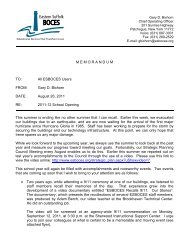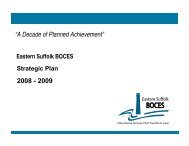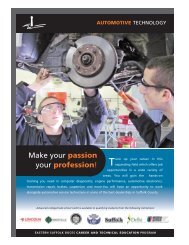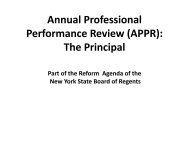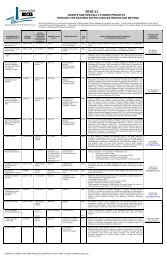Presentation on Common Core Standards, NYLA Conference ...
Presentation on Common Core Standards, NYLA Conference ...
Presentation on Common Core Standards, NYLA Conference ...
Create successful ePaper yourself
Turn your PDF publications into a flip-book with our unique Google optimized e-Paper software.
Jim Belair- SLS Director, M<strong>on</strong>roe 2 Orleans BOCES School Library System<br />
John Brock- Associate in School Library Services, NYSED<br />
Nancy Greco-Instructi<strong>on</strong> & Archives Librarian, St. John Fisher College<br />
Mary Ratzer- School Librarian, Shenedehowa Central Schools - Retired
College & Career Readiness<br />
Problem Solving Skills<br />
Critical Thinking Skills<br />
Vocabulary<br />
Informati<strong>on</strong>al Text<br />
The standards will help prepare students with the<br />
knowledge and skill they need to succeed in educati<strong>on</strong>al and<br />
job related training after high school.
Students who are Career and College Ready in Reading, Writing,<br />
Speaking, Listening, and Language…<br />
1.. dem<strong>on</strong>strate<br />
independence.<br />
4. comprehend as well<br />
as critique.<br />
2. build str<strong>on</strong>g c<strong>on</strong>tent<br />
knowledge.<br />
5. value evidence.<br />
7. come to understand<br />
other perspectives and<br />
cultures.<br />
3. resp<strong>on</strong>d to the<br />
varying demands of<br />
audience, task,<br />
purpose, and<br />
discipline.<br />
6. use technology and<br />
digital media<br />
strategically and<br />
capably.
College Instructors and Employers Say Graduates<br />
Are Not Prepared for College and Work<br />
5<br />
100%<br />
75%<br />
50%<br />
25%<br />
0%<br />
Average estimated proporti<strong>on</strong>s of recent high<br />
school graduates who are not prepared<br />
42%<br />
45%<br />
College Instructors Employers<br />
Source: Peter D. Hart Research Associates/Public Opini<strong>on</strong> Strategies, Rising to the Challenge: Are High<br />
School Graduates Prepared for College and Work? prepared for Achieve, Inc., 2005.
Achieve America’s Diploma Project<br />
Ec<strong>on</strong>omic reality reflects c<strong>on</strong>verging<br />
expectati<strong>on</strong>s.<br />
Nearly 80% of future job openings in the next<br />
decade in the U.S. will require postsec<strong>on</strong>dary<br />
educati<strong>on</strong> or training.<br />
45% will be in “middle skill” occupati<strong>on</strong>s, which<br />
require at least some postsec<strong>on</strong>dary educati<strong>on</strong> and<br />
training<br />
33% will be in high skilled occupati<strong>on</strong>s for which<br />
a Bachelors degree or more is required.<br />
By c<strong>on</strong>trast, <strong>on</strong>ly 22% of future job openings<br />
will be “low skill” and accessible to those with a<br />
high school diploma
What the CCLS are, and what<br />
they are not<br />
Dispelling comm<strong>on</strong> mispercepti<strong>on</strong>s about<br />
the CCLS
Myths vs. Facts<br />
Myth: No teachers were involved in writing the <strong>Standards</strong>.<br />
Fact: Teachers and standards experts from across the country<br />
were involved.<br />
Myth: The <strong>Standards</strong> are not research or evidence based.<br />
Fact: The <strong>Standards</strong> have used of a large body of research and<br />
evidence.<br />
Myth: The <strong>Standards</strong> are not internati<strong>on</strong>ally benchmarked.<br />
Fact: Internati<strong>on</strong>al benchmarking played a significant role in<br />
both sets of standards<br />
Myth: The <strong>Standards</strong> tell teachers what to teach.<br />
Fact:. The standards establish what students need to learn, but<br />
they will not dictate how teachers should teach.
Myths vs. Facts (c<strong>on</strong>t.)<br />
Myth: The <strong>Standards</strong> <strong>on</strong>ly include skills and do not address the<br />
importance of c<strong>on</strong>tent knowledge.<br />
Fact: The <strong>Standards</strong> recognize that both c<strong>on</strong>tent and skills are important.<br />
Myth: Adopting comm<strong>on</strong> standards will bring states down to the lowest<br />
comm<strong>on</strong> denominator.<br />
Fact: These standards focus <strong>on</strong> all students and their success in college<br />
and their careers.<br />
Myth: The <strong>Standards</strong> are descripti<strong>on</strong>s of skills; they d<strong>on</strong>’t include a<br />
reading list or reference to c<strong>on</strong>tent.<br />
Fact: The <strong>Standards</strong> include sample texts at the level of complexity<br />
appropriate for the grade level.<br />
Myth: English teachers will be asked to teach science and social studies<br />
reading materials.<br />
Fact: English teachers teach literature as well as literary n<strong>on</strong>-ficti<strong>on</strong>.<br />
These standards also ensure students are being prepared to read, write,<br />
and research across the curriculum, including in history and science.
Myths vs. Facts (c<strong>on</strong>t.)<br />
Myth: The <strong>Standards</strong> will be implemented through No Child<br />
Left Behind (NCLB) –<br />
Fact: The <strong>Standards</strong> are not part of NCLB and adopti<strong>on</strong> is<br />
not mandatory.<br />
Myth: The federal government will take over ownership of the<br />
Comm<strong>on</strong> <strong>Core</strong> State <strong>Standards</strong> Initiative.<br />
Fact: The federal government will not govern the Comm<strong>on</strong><br />
<strong>Core</strong> State <strong>Standards</strong> Initiative.<br />
Myth: These <strong>Standards</strong> are nati<strong>on</strong>al curriculum for schools.<br />
Fact: The <strong>Standards</strong> are not a curriculum. They are a set of<br />
goals and expectati<strong>on</strong>s for knowledge and skills that will help<br />
our students succeed.
Break into Groups<br />
Read the Shift given to your group<br />
Describe the Shift <strong>on</strong> Chart paper<br />
Be prepared to share
Shift 1<br />
Balancing Informati<strong>on</strong>al & Literary Texts<br />
Students read a true balance of informati<strong>on</strong>al and<br />
literary texts. Elementary school classrooms are,<br />
therefore, places where students access the world –<br />
science, social studies, the arts and literature –<br />
through text. At least 50% of what students read is<br />
informati<strong>on</strong>al.
Shift 1: What is read in school<br />
Informati<strong>on</strong> Text<br />
Narrative N<strong>on</strong>-Ficti<strong>on</strong><br />
Literary Text<br />
Appendix B<br />
At least 50% is informati<strong>on</strong>al<br />
Research shows students do not read informati<strong>on</strong>al<br />
text and remember what they read- College and Career<br />
Ready
Shift 2<br />
Knowledge in the Disciplines<br />
C<strong>on</strong>tent area teachers outside of the ELA classroom<br />
emphasize literacy experiences in their planning and<br />
instructi<strong>on</strong>. Students learn through domain specific<br />
texts in science and social studies classrooms – rather<br />
than referring to the text, they are expected to learn<br />
from what they read.
Shift 2: Read in other areas<br />
Read in Science<br />
Read in Social Studies<br />
Read in …<br />
Students will learn from what they read
Shift 3<br />
Staircase of Complexity<br />
In order to prepare students for the complexity of<br />
college and career ready texts, each grade level<br />
requires a “step” of growth <strong>on</strong> the “staircase”. Students<br />
read the central, grade appropriate text around which<br />
instructi<strong>on</strong> is centered. Teachers are patient, create<br />
more time and space in the curriculum for this close<br />
and careful reading, and provide appropriate and<br />
necessary scaffolding and supports so that it is possible<br />
for students reading below grade level.
Shift 3: Staircase of complexity<br />
Every year, student climb a “step” of knowledge<br />
Students not reading at levels needed<br />
Teachers provide scaffolding<br />
Lexile, Fountas and Pinnell, DRA, Accelerated Reader,<br />
Reading Counts<br />
We understand argument<br />
around leveled reading!
Shift 4<br />
Text-based Answers<br />
Students have rich and rigorous c<strong>on</strong>versati<strong>on</strong>s which<br />
are dependent <strong>on</strong> a comm<strong>on</strong> text. Teachers insist that<br />
classroom experiences stay deeply c<strong>on</strong>nected to the<br />
text <strong>on</strong> the page and that students develop habits for<br />
making evidentiary arguments both in c<strong>on</strong>versati<strong>on</strong>,<br />
as well as in writing to assess comprehensi<strong>on</strong> of a text.
Shift 4: Text Based Answers<br />
Read closely for informati<strong>on</strong><br />
Informati<strong>on</strong> based directly <strong>on</strong> text<br />
Evidence comes from text to support argument
Shift 5<br />
Writing from Sources<br />
Writing needs to emphasize use of evidence to inform<br />
or make an argument rather than the pers<strong>on</strong>al<br />
narrative and other forms of dec<strong>on</strong>textualized<br />
prompts. While the narrative still has an important<br />
role, students develop skills through written<br />
arguments that resp<strong>on</strong>d to the ideas, events, facts, and<br />
arguments presented in the texts they read.
Shift 5: Writing from Sources<br />
Evidence from text<br />
Written resp<strong>on</strong>se<br />
Use of multiple sources<br />
Analyze and synthesize
Shift 6<br />
Academic Vocabulary<br />
Students c<strong>on</strong>stantly build the vocabulary they need to<br />
access grade level complex texts. By focusing<br />
strategically <strong>on</strong> comprehensi<strong>on</strong> of pivotal and<br />
comm<strong>on</strong>ly found words (such as “discourse,”<br />
“generati<strong>on</strong>,” “theory,” and “principled”) and less <strong>on</strong><br />
esoteric literary terms (such as “<strong>on</strong>omatopoeia” or<br />
“hom<strong>on</strong>ym”), teachers c<strong>on</strong>stantly build students’<br />
ability to access more complex texts across the c<strong>on</strong>tent<br />
areas.
Shift 6: Academic Vocabulary<br />
Build vocabulary<br />
Words chosen strategically across disciplines<br />
Meaningful words
Shifts in Mathematics<br />
26<br />
Shift 1 Focus Teachers significantly narrow and deepen the scope of how time and energy is<br />
spent in the math classroom. They do so in order to focus deeply <strong>on</strong> <strong>on</strong>ly the<br />
c<strong>on</strong>cepts that are prioritized in the standards.<br />
Shift 2 Coherence Principals and teachers carefully c<strong>on</strong>nect the learning within and across grades<br />
so that students can build new understanding <strong>on</strong>to foundati<strong>on</strong>s built in previous<br />
years.<br />
Shift 3 Fluency Students are expected to have speed and accuracy with simple calculati<strong>on</strong>s;<br />
teachers structure class time and/or homework time for students to memorize,<br />
through repetiti<strong>on</strong>, core functi<strong>on</strong>s.<br />
Shift 4 Deep<br />
Understand<br />
ing<br />
Students deeply understand and can operate easily within a math c<strong>on</strong>cept before<br />
moving <strong>on</strong>. They learn more than the trick to get the answer right. They learn<br />
the math.<br />
Shift 5 Applicati<strong>on</strong> Students are expected to use math and choose the appropriate c<strong>on</strong>cept for<br />
applicati<strong>on</strong> even when they are not prompted to do so.<br />
Shift 6 Dual<br />
Intensity<br />
Students are practicing and understanding. There is more than a balance<br />
between these two things in the classroom – both are occurring with intensity.
Math Shifts- What’s Different?<br />
Apply math c<strong>on</strong>cepts in “real world” situati<strong>on</strong>s. Teachers in<br />
c<strong>on</strong>tent areas outside of math, particularly science, ensure that<br />
students are using math to make meaning of and access c<strong>on</strong>tent.<br />
Students move bey<strong>on</strong>d THE RIGHT ANSWER. They dem<strong>on</strong>strate deep<br />
c<strong>on</strong>ceptual understanding of core math c<strong>on</strong>cepts by applying them to<br />
new situati<strong>on</strong>s as well as writing and speaking about their<br />
understanding.<br />
Understand the world mathematically.<br />
Use mathematics to make decisi<strong>on</strong>s and real world c<strong>on</strong>necti<strong>on</strong>s.<br />
Comm<strong>on</strong> <strong>Core</strong> – Mathematics - KEY IDEAS<br />
http://www.corestandards.org/about-the-standards/key-points-in-mathematics
No l<strong>on</strong>ger ‘cool’ to ‘not do the<br />
math’<br />
Dr. Andrew Chen: President, EduTr<strong>on</strong>, professor,<br />
research scientist MIT, c<strong>on</strong>sultant with Institute for<br />
Educati<strong>on</strong> Science at U.S. Dept. of Educati<strong>on</strong>, Achieve,<br />
Inc., Comm<strong>on</strong> <strong>Core</strong> State <strong>Standards</strong> Development<br />
Team in Mathematics, Advisory Board of the Nati<strong>on</strong>al<br />
Council <strong>on</strong> Teacher Quality<br />
takes a whole village to build a math culture.
Moving to a Math culture<br />
Changing beliefs from a focus <strong>on</strong> ability to a focus <strong>on</strong><br />
effort increases engagement in mathematics learning,<br />
improves mathematics outcomes<br />
“… there are people who always say that there are math<br />
people and there are not math people. What if that is<br />
all an illusi<strong>on</strong>? What if there were no such thing as<br />
math people or not math people? But there is a group<br />
of people that had enough practice with the core of<br />
number and operati<strong>on</strong>s and the command of it and<br />
the quantities that measure and those other things<br />
…so that door opens? ”
Shifts in Mathematics<br />
30<br />
Shift 1 Focus Teachers significantly narrow and deepen the scope of how time and energy is<br />
spent in the math classroom. They do so in order to focus deeply <strong>on</strong> <strong>on</strong>ly the<br />
c<strong>on</strong>cepts that are prioritized in the standards.<br />
Shift 2 Coherence Principals and teachers carefully c<strong>on</strong>nect the learning within and across grades<br />
so that students can build new understanding <strong>on</strong>to foundati<strong>on</strong>s built in previous<br />
years.<br />
Shift 3 Fluency Students are expected to have speed and accuracy with simple calculati<strong>on</strong>s;<br />
teachers structure class time and/or homework time for students to memorize,<br />
through repetiti<strong>on</strong>, core functi<strong>on</strong>s.<br />
Shift 4 Deep<br />
Understand<br />
ing<br />
Students deeply understand and can operate easily within a math c<strong>on</strong>cept before<br />
moving <strong>on</strong>. They learn more than the trick to get the answer right. They learn<br />
the math.<br />
Shift 5 Applicati<strong>on</strong> Students are expected to use math and choose the appropriate c<strong>on</strong>cept for<br />
applicati<strong>on</strong> even when they are not prompted to do so.<br />
Shift 6 Dual<br />
Intensity<br />
Students are practicing and understanding. There is more than a balance<br />
between these two things in the classroom – both are occurring with intensity.
Math Shifts- What’s Different?<br />
Apply math c<strong>on</strong>cepts in “real world” situati<strong>on</strong>s. Teachers in<br />
c<strong>on</strong>tent areas outside of math, particularly science, ensure that<br />
students are using math to make meaning of and access c<strong>on</strong>tent.<br />
Students move bey<strong>on</strong>d THE RIGHT ANSWER. They dem<strong>on</strong>strate deep<br />
c<strong>on</strong>ceptual understanding of core math c<strong>on</strong>cepts by applying them to<br />
new situati<strong>on</strong>s as well as writing and speaking about their<br />
understanding.<br />
Understand the world mathematically.<br />
Use mathematics to make decisi<strong>on</strong>s and real world c<strong>on</strong>necti<strong>on</strong>s.<br />
Comm<strong>on</strong> <strong>Core</strong> – Mathematics - KEY IDEAS<br />
http://www.corestandards.org/about-the-standards/key-points-in-mathematics
CC Anchor <strong>Standards</strong><br />
www.wordle.net
Reading Writing Speaking/<br />
Listening<br />
Key ideas and<br />
details<br />
Craft and<br />
Structure<br />
Integrati<strong>on</strong> of<br />
Knowledge and<br />
Ideas<br />
Range of<br />
Reading and Level<br />
of Text Complexity<br />
Text types and<br />
purposes<br />
Producti<strong>on</strong> and<br />
Distributi<strong>on</strong> of<br />
Writing<br />
Research to<br />
Build and<br />
Present Knowledge<br />
Comprehensi<strong>on</strong><br />
and<br />
Collaborati<strong>on</strong><br />
<str<strong>on</strong>g>Presentati<strong>on</strong></str<strong>on</strong>g> of<br />
Knowledge and<br />
Ideas<br />
Language<br />
C<strong>on</strong>venti<strong>on</strong>s of<br />
Standard<br />
English<br />
Knowledge of<br />
language<br />
Vocabulary<br />
Acquisiti<strong>on</strong> and<br />
Use
Key Design c<strong>on</strong>siderati<strong>on</strong>s<br />
grade-specific<br />
Grade levels for K–8; grade bands for 9–10 and 11–12<br />
focus <strong>on</strong> results rather than means<br />
integrated model of literacy<br />
Research and media skills blended into the <strong>Standards</strong><br />
as a whole<br />
Shared resp<strong>on</strong>sibility for students’ literacy<br />
development
Argumentative/Persuasive<br />
A reas<strong>on</strong>ed, logical way of dem<strong>on</strong>strating that the<br />
writer’s positi<strong>on</strong>, belief, or c<strong>on</strong>clusi<strong>on</strong> is valid through<br />
text-based evidence<br />
ELA: Claims about<br />
worth or meaning of<br />
literary works<br />
History/SS: Analyze<br />
evidence and argue for<br />
interpretati<strong>on</strong>s<br />
Science: Statements/<br />
C<strong>on</strong>clusi<strong>on</strong>s that use<br />
data to argue for<br />
soluti<strong>on</strong>s to problems
A Real-life example at<br />
St. John Fisher College<br />
Freshmen Seminar Class<br />
Critical Thinking and the College Archives<br />
• Acclimate students to campus and help develop skills for<br />
college success<br />
• Create a nurturing envir<strong>on</strong>ment – student-to-student/ facultyto-student<br />
• Foster a c<strong>on</strong>necti<strong>on</strong> to the college
The Students were asked to carefully examine<br />
the following types of documents
Freshmen Students’ First<br />
Reacti<strong>on</strong> to this Exercise<br />
• Perplexed<br />
• C<strong>on</strong>fused<br />
• Uncomfortable<br />
What the students expected:<br />
• That I would tell them the story and they would<br />
need to remember it and repeat it back in an<br />
assignment<br />
I was able to look at old documents and analysis them helping to stretch<br />
my brain and do some deep thinking.<br />
I learned that you have to work for the answers to things, and sometimes<br />
it will be frustrating, c<strong>on</strong>fusing, and vague, but you just have to pay<br />
attenti<strong>on</strong> to details to get the answers.<br />
This exercise benefited my ability to think critically and effectively read<br />
texts.<br />
It was also very interesting to use these primary sources of informati<strong>on</strong> as they<br />
give you a different perspective <strong>on</strong> history compared to reading a textbook. I<br />
feel that they give you a deeper understanding of what really happened.
ANCHOR<br />
Integrati<strong>on</strong> of knowledge and ideas:<br />
Use their experience and their knowledge…and logic to<br />
think analytically, address problems creatively, and<br />
advocate persuasively<br />
Integrate and evaluate multiple sources of informati<strong>on</strong><br />
presented in different media or formats to address a<br />
questi<strong>on</strong> or solve a problem
ANCHOR<br />
Research to build and present knowledge:<br />
C<strong>on</strong>duct short as well more sustained research<br />
projects to answer a questi<strong>on</strong> (including a selfgenerated<br />
questi<strong>on</strong>) drawing <strong>on</strong> several sources<br />
Develop factual, interpretive, and evaluative<br />
questi<strong>on</strong>s for further explorati<strong>on</strong> of the topic<br />
Draw evidence from literary or informati<strong>on</strong>al texts<br />
to support analysis, reflecti<strong>on</strong>, and research<br />
Gather relevant informati<strong>on</strong> from multiple print<br />
and digital sources, assess the credibility and<br />
accuracy of each source, and integrate the<br />
informati<strong>on</strong> avoiding plagiarism
ANCHOR<br />
Producti<strong>on</strong> and distributi<strong>on</strong> of Writing:<br />
Use technology, including the Internet, to produce<br />
and publish writing and to interact and collaborate<br />
with others<br />
Write arguments to support claims in an analysis of<br />
substantive topics or texts using valid reas<strong>on</strong>ing<br />
and relevant and sufficient texts<br />
Explore and inquire into areas of interest to<br />
formulate an argument
ANCHOR<br />
Comprehensi<strong>on</strong> and collaborati<strong>on</strong>:<br />
Integrate and evaluate informati<strong>on</strong> presented in<br />
diverse media and formats, including visually,<br />
quantitatively, and orally<br />
Prepare for and participate effectively in a range of<br />
c<strong>on</strong>versati<strong>on</strong>s and collaborati<strong>on</strong>s with diverse<br />
partners, building <strong>on</strong> other’s ideas and expressing<br />
their own clearly and persuasively
ANCHOR<br />
<str<strong>on</strong>g>Presentati<strong>on</strong></str<strong>on</strong>g> of knowledge and ideas:<br />
Present informati<strong>on</strong>, findings, and supporting<br />
evidence such that listeners can follow the line of<br />
reas<strong>on</strong>ing and the organizati<strong>on</strong>, development, and<br />
style are appropriate to task, purpose and audience<br />
Make strategic use of digital media and visual<br />
displays of data to express informati<strong>on</strong> and<br />
enhance understanding
• Text Types and Purposes<br />
Write arguments to support claims in analysis<br />
of substantive topics or texts, using valid<br />
reas<strong>on</strong>ing and relevant and sufficient evidence<br />
Write informative/explanatory texts to<br />
examine and covey complex ideas and<br />
informati<strong>on</strong> clearly and accurately through<br />
effective selecti<strong>on</strong>, organizati<strong>on</strong>, and analysis<br />
of c<strong>on</strong>tent.<br />
Write narratives to develop real or imagined<br />
experiences or events using…well chosen<br />
details.
How can Public Libraries help<br />
support the Comm<strong>on</strong> <strong>Core</strong><br />
Learning <strong>Standards</strong>
How can Academic Libraries<br />
help support the Comm<strong>on</strong> <strong>Core</strong><br />
Learning <strong>Standards</strong>
• We’ve got the goods!<br />
• Access to many research databases <strong>on</strong>site<br />
• Digital repositories for primary resources<br />
• University of Rochester Online Collecti<strong>on</strong>s<br />
• St. John Fisher College Special Collecti<strong>on</strong>s<br />
• UB Libraries Digital Collecti<strong>on</strong>s<br />
• We can introduce your students to college research<br />
• High School Research Visits<br />
• We may not advertise, make the first move<br />
• Make requests during our down-time – after<br />
Thanksgiving, first weeks in January, after the first<br />
week in May
Recap…<br />
College & Career Ready<br />
Problem Solving Skills<br />
Critical Thinking Skills
PTA Resources
PTA Resources
C<strong>on</strong>tact Informati<strong>on</strong><br />
Jim Belair<br />
jbelair@m<strong>on</strong>roe2boces.org<br />
John Brock<br />
jbrock@mail.nysed.gov<br />
Nancy Greco<br />
ngreco@sjfc.edu<br />
Mary Ratzer<br />
mainely4@yahoo.com


